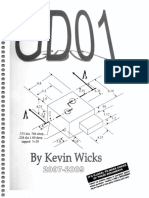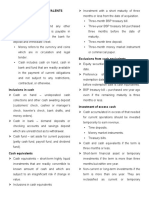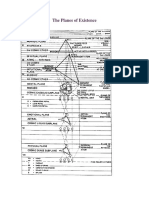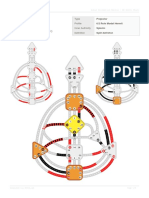Iv.-Cash and Cash Equivalents
Iv.-Cash and Cash Equivalents
Uploaded by
by ScribdCopyright:
Available Formats
Iv.-Cash and Cash Equivalents
Iv.-Cash and Cash Equivalents
Uploaded by
by ScribdOriginal Title
Copyright
Available Formats
Share this document
Did you find this document useful?
Is this content inappropriate?
Copyright:
Available Formats
Iv.-Cash and Cash Equivalents
Iv.-Cash and Cash Equivalents
Uploaded by
by ScribdCopyright:
Available Formats
Ateneo de Zamboanga University
ACCOUNTANCY ACADEMIC ORGANIZATION
A School of Management and Accountancy Student Government
Cash and Cash Equivalent
Cash Cash Equivalents
Includes money or its equivalent (i.e. Short-term, highly liquid investments
negotiable instruments) that is readily that are readily convertible to known
available for unrestricted use amounts of cash and which are subject
May be: to an insignificant risk of changes in
a.Cash on hand – includes undeposited value
collections awaiting deposit and other Only those highly liquid investments
current funds that are acquired 3 months or less
b. Cash in bank – includes deposits in before maturity can qualify as cash
banks that are available for withdrawal equivalents
and unrestricted use Examples:
Examples: a.3-month Treasury bill
a.Coins and currencies b. 90-day money market
b. Demand deposits and savings account instrument or commercial paper
c.Bank drafts and money orders c.3-month time deposit
d. Checks (i.e. Cashier’s, Personal, d. 1-year Treasury bill acquired
Manager’s and Certified Checks) 3 months before maturity
e.Cash funds set aside for use in current e.Redeemable preference shares
operations (i.e. petty cash, revolving, acquired 3 months before redemption
payroll, change, dividend, tax, travel and date
interest funds) Checks and bank drafts cannot qualify
f. Unrestricted deposits in foreign banks as cash equivalents because these are
g. Compensating balances that are not not short-term investments and when
legally restricted for withdrawal they are available for unrestricted use,
h. Stale checks – checks delivered to they are included as cash but not cash
payees but are not encashed within a equivalents.
relatively long period. They are reverted Equity securities cannot qualify as
back to cash. cash equivalents because they do not
i. Undelivered and postdated checks drawn have maturity date.
– no actual payment has been made
hence is reverted back to cash Bank Overdraft
Items not included as cash: Bank overdraft (cash overdraft) is a negative
a.Postdated checks received – only (credit) balance in the cash in bank
available for use at a future date and (checking) account resulting from
thus, are not cash. They are reverted overpayment of checks in excess of the
back to accounts receivable at reporting amount of deposit.
date.
Overdrafts are payable on demand, thus,
b. IOUs (“I owe you”) or advances to
they are presented as current liabilities. They
employees – treated as receivables
are not offset to cash, except in cases where
c.Postage stamps – treated as prepaid supplies
offsetting is permitted:
d. Restricted deposits in foreign banks
e.Compensating balances that are legally When two or more accounts are maintained
restricted for withdrawal in the same bank, an overdraft in one
f. Cash funds not available for use in account may be offset or deducted from
current operations (i.e. sinking, plant another with positive balance; provided, the
expansion, depreciation, preference other bank account is also unrestricted and
share redemption, contingency and such overdrafts form an integral part of the
insurance funds) entity’s cash management.
g. Unused credit line – disclosed only
in the notes
Recognition, Presentation and Measurement of Cash
Accountancy Academic Organization Tutorials 2020 1
Ateneo de Zamboanga University
ACCOUNTANCY ACADEMIC ORGANIZATION
A School of Management and Accountancy Student Government
Cash is recognized when it meets the requirements for asset recognition and is available for
unrestricted use in current operations.
Unrestricted cash and unrestricted cash equivalents acquired 3 months or less before maturity are
combined and presented as one line item under the caption “Cash and cash equivalents”. The
breakdown of which is shown in the notes. Restricted cash is excluded from cash and presented
under other line item as either current or non-current asset.
Cash is measured at face amount (face value). Cash denominated in foreign currency is
translated at the current exchange rate as of reporting date. Cash maintained in a bank
undergoing bankruptcy is excluded from cash and presented as receivable at realizable value.
Internal controls over cash
1. Segregation of incompatible duties – authorization, execution, recording and custody over
cash should be segregated to reduce the risk of embezzlement of cash
2. Imprest system – all cash receipts should be deposited intact and all cash disbursements
should be made through checks
3. Bank reconciliation – requires timely reconciliation of the differences between the cash
balance per books and the cash balance per bank statement.
4. Cash counts – periodic tally of actual cash and reconciliation with the cash balance per records
5. Minimum cash balance – maintaining minimum cash balance that is sufficient only to defray
specific business requirements
6. Lockbox accounts – used to expedite cash collections and to ensure that cash collections are
deposited intact.
7. Non-encashment of personal checks from petty cash fund – to discourage concealment of
cash shortages
8. Voucher system – a voucher is prepared for every cash disbursement in order to ensure that
each disbursement is properly authorized, made for a valid expenditure, and properly
recorded
Accounting for cash shortages and overages
Cash shortage – occurs when the actual amount through physical cash count is less than the
balance recorded in the books. It is initially debited to a suspense account called “Cash shortage
or overage” pending proper investigation:
Date Cash shortage or overage xx
Cash on hand xx
Depending on the result of the investigation, the shortage may be: (1) closed to a receivable
account if the shortage is due to the fault of an employee, or; (2) charged to loss if the
investigation was without merit:
Date Receivable from cashier/ Loss on cash xx
shortage
Cash shortage or overage xx
Cash overage – occurs when the actual amount through physical cash count is greater than the
balance recorded in the books. It is initially credited to a suspense account called “Cash shortage
or overage” pending proper investigation.
Depending on the result of the investigation, the overage may be: (1) closed to a payable account
if the overage is due to cash belonging to an employee, or; (2) charged to gain if the investigation
was without merit.
Concealment of cash shortages
Accountancy Academic Organization Tutorials 2020 2
Ateneo de Zamboanga University
ACCOUNTANCY ACADEMIC ORGANIZATION
A School of Management and Accountancy Student Government
1. Lapping – occurs when collection of receivable from one customer is misappropriated and
then concealed by applying a subsequent collection from another customer. It is made
possible when the incompatible duties of recording and custody of cash are combined.
2. Kiting – occurs when cash shortage is concealed by overstating the balance of cash. It is made
possible by exploiting the float period (the time it needs for a check to clear at the bank).
3. Window dressing (cooking the books) – occurs when books are not closed at year-end and
transactions in the subsequent period (i.e. sales and disbursements) are deliberately recorded
in the current period in order to improve the entity’s financial performance or financial ratios.
Accounting for petty cash fund
Petty cash fund is money set aside to defray relatively small amounts of cash disbursements. The
accounting procedures for petty cash fund are:
a. Petty cash fund is established – by means of a check drawn to the order of petty cash
custodian in conformance with the imprest system
Date Petty Cash Fund xx
Cash in bank xx
The amount of petty cash fund is fixed by a board resolution. If the original amount
established is ₱10,000 and disbursement during the period reduced the fund balance to
₱2,000, the amount of subsequent replenishment is ₱8,000.
b. Disbursements out of the petty cash fund – no journal entries are made. Instead, petty cash
payments are initially recorded in a petty cash register and supported by signed vouchers.
c. Replenishment of petty cash disbursements – when the fund balance becomes low, it may be
replenished through check and is supported by a check disbursement voucher. A journal
entry is made for the disbursements during the period that were initially recorded in the register:
Date Various expense accounts xx
Cash in bank xx
d. Adjustment for unreplenished fund at reporting date – any unreplenished petty cash fund
should be adjusted at the end of the period in order not to overstate cash and understate expenses:
Date Various expense accounts xx
Petty Cash Fund xx
e. Subsequent changes in ledger balance of petty cash fund:
Date Petty Cash Fund xx
Cash in bank xx
to increase the petty cash fund balance
Date Cash in bank xx
Petty Cash Fund xx
to decrease the petty cash fund balance
f. Shortage in petty cash fund – the amount of replenishment is increased by the cash shortage:
Date Various expense accounts xx
Cash shortage or overage xx
Cash in bank xx
g. Overage in petty cash fund – the amount of replenishment is decreased by the cash overage:
Date Various expense accounts xx
Cash shortage or overage xx
Cash in bank xx
Bank Reconciliation
Accountancy Academic Organization Tutorials 2020 3
Ateneo de Zamboanga University
ACCOUNTANCY ACADEMIC ORGANIZATION
A School of Management and Accountancy Student Government
Bank reconciliation is a schedule prepared on a monthly basis to account for any difference
between the cash balance per books and the cash balance per bank statement.
Bank reconciliations are normally required only for checking accounts. And when the entity has
more than one account, separate reconciliation is made for each of the accounts.
Common causes of differences between cash balances per books and per bank statement (other
than fraud) are:
1. Deposits in transit – deposits already made but not yet received by the bank, or received by
the bank but due to cut-off, are not yet included (credited) in the depositor’s bank statement
2. Outstanding checks – checks drawn and released to payees but are not yet presented for
encashment to the bank. Certified checks should be excluded from outstanding checks as
they are already deducted from the entity’s account, thus, they are no longer outstanding.
Outstanding checks that became stale may appropriately be reverted back to cash.
3. Credit memos – these are additions (bank credits) made by the bank to the entity’s bank
account but not yet recorded by the entity. Examples are:
a.Collections made by the bank in behalf of the entity
b. Proceeds from loan directly credited or added by the bank to the entity’s bank account
c.Unrolled-over matured time deposits transferred by the bank to the entity’s bank account.
4. Debit memos – these are deductions (bank debits) made by the bank to the entity’s bank
account but not yet recorded by the entity. Examples are:
a.Banks service charges for checkbook, interest, collection, penalties and surcharges
b. No sufficient funds checks (NSF) – checks deposited and already recorded by the bank
but subsequently returned because the drawer’s fund is insufficient to the pay the check
c.Automatic debits (i.e. automatic payment of bills by the bank in behalf of the entity)
d. Payment of loans – payment the entity agreed to be made out directly from its bank
account
5. Errors – committed by either the bank (bank error) or the entity (book error)
Deposits in-transit, outstanding checks and errors committed by the bank are bank reconciling
items. No reconciling entries are made by the entity (depositor).
Credit memos, debit memos and errors committed in the books are book reconciling items. The
entity (depositor) should make reconciling entries for these items.
A pro forma bank reconciliation is shown below:
Balance per books, end xx Balance per bank statement, end xx
Add: Credit memos (CM) xx Add: Deposits in transit (DIT) xx
Less: Debit memos (DM) (xx) Less: Outstanding checks (OC) (xx)
Add/less: Book errors xx Add/less: Bank errors xx
Adjusted balance xx Adjusted balance xx
Accountancy Academic Organization Tutorials 2020 4
You might also like
- Guam Drivers Written Exam Study GuideDocument10 pagesGuam Drivers Written Exam Study Guidecindy Promo100% (10)
- Cash and Cash Equivalents PDFDocument4 pagesCash and Cash Equivalents PDFJade Gomez100% (1)
- GD01 Lab ManualDocument34 pagesGD01 Lab ManualMichael McCoyNo ratings yet
- Module 1 - Cash and Cash EquivalentsDocument16 pagesModule 1 - Cash and Cash EquivalentsJehPoy0% (1)
- Cash PDFDocument10 pagesCash PDFGabriel JonNo ratings yet
- LOGAN - An Introduction To Nonlinear Partial Differential Equations PDFDocument205 pagesLOGAN - An Introduction To Nonlinear Partial Differential Equations PDFDébora MottaNo ratings yet
- RamSync BriefDocument5 pagesRamSync Briefjoshua arnettNo ratings yet
- Ia1 Mod 1Document9 pagesIa1 Mod 1omssheshNo ratings yet
- Cash and Cash EquivalentsDocument9 pagesCash and Cash EquivalentsJna MarieNo ratings yet
- ReviewerDocument67 pagesReviewerKyungsoo DohNo ratings yet
- BedhewbdjkewDocument16 pagesBedhewbdjkewMaica A.No ratings yet
- 02 Chapter 2 Cash and Cash EquivalentsDocument10 pages02 Chapter 2 Cash and Cash Equivalentssoyoung kimNo ratings yet
- Assets - Syn 101Document35 pagesAssets - Syn 101Marianne SironNo ratings yet
- 02 - Cash & Cash EquivalentDocument5 pages02 - Cash & Cash EquivalentEmmanuel100% (1)
- Cash and Cash EquivalentsDocument3 pagesCash and Cash EquivalentsKate CamachoNo ratings yet
- Nature of Cash AccountDocument10 pagesNature of Cash AccountLorena PernatoNo ratings yet
- 02 Cash Cash EquivalentDocument5 pages02 Cash Cash EquivalentalteregoNo ratings yet
- #10 Cash and Cash EquivalentsDocument2 pages#10 Cash and Cash Equivalentsmilan100% (3)
- 3 Cash - Lecture Notes PDFDocument11 pages3 Cash - Lecture Notes PDFJohn Paul EslerNo ratings yet
- Financial Accounting and Reporting, Cash and Cash EquivalentDocument3 pagesFinancial Accounting and Reporting, Cash and Cash Equivalentgodardo suraltaNo ratings yet
- Lecture No.1 Cash Cash Equiv TheoriesDocument3 pagesLecture No.1 Cash Cash Equiv TheoriesbsasociondaisyremarieNo ratings yet
- Topic 5 - Cash and Cash Equivalent - Rev (Students)Document31 pagesTopic 5 - Cash and Cash Equivalent - Rev (Students)Novian Dwi Ramadana0% (1)
- CHAPTER 1-Cash and Cash EquivalentsDocument43 pagesCHAPTER 1-Cash and Cash EquivalentsMarriel Fate CullanoNo ratings yet
- Cash and Cash EquivalentsDocument408 pagesCash and Cash EquivalentsJanea Arinya100% (1)
- Cash EquivalentDocument8 pagesCash EquivalentEyra MercadejasNo ratings yet
- 10 Cash and Cash EquivalentsDocument2 pages10 Cash and Cash EquivalentsuncianojhezrhyllemhaeNo ratings yet
- Module 1Document12 pagesModule 1bhettyna noayNo ratings yet
- Cash and Cash EquivalentsDocument3 pagesCash and Cash Equivalentsazieruga32No ratings yet
- C and CE NotesDocument4 pagesC and CE NotesFrancine PimentelNo ratings yet
- Topic 5 - Cash and Cash Equivalent - Rev (Students)Document31 pagesTopic 5 - Cash and Cash Equivalent - Rev (Students)RomziNo ratings yet
- Cash and Cash EquivalentDocument5 pagesCash and Cash EquivalentMASIGLAT, CRIZEL JOY, Y.No ratings yet
- Cash and Cash EquivalentsDocument11 pagesCash and Cash Equivalentskrisha milloNo ratings yet
- Cash and Cash EquivalentsDocument3 pagesCash and Cash EquivalentsNath BongalonNo ratings yet
- Audit Problems FinalDocument48 pagesAudit Problems FinalShane TabunggaoNo ratings yet
- TUESDAYDocument13 pagesTUESDAYBryan Red AngaraNo ratings yet
- Module 1 - Cash and Cash EquivalentsDocument10 pagesModule 1 - Cash and Cash EquivalentsGRACE ANN BERGONIONo ratings yet
- Financial Accounting and Reporting: Cash and Cash Equivalent CashDocument4 pagesFinancial Accounting and Reporting: Cash and Cash Equivalent CashJAPNo ratings yet
- Summary of Cash and Cash EquivalentsDocument4 pagesSummary of Cash and Cash EquivalentsMhico Mateo100% (1)
- 00 Quick Notes - Cash and Cash Equivalents PDFDocument6 pages00 Quick Notes - Cash and Cash Equivalents PDFBecky GonzagaNo ratings yet
- Intermediate Accounting 1a Cash and Cash EquivalentsDocument8 pagesIntermediate Accounting 1a Cash and Cash EquivalentsGinalyn FormentosNo ratings yet
- White PaperDocument5 pagesWhite PaperZara Jane DinhayanNo ratings yet
- Cash and Cash EquivalentDocument3 pagesCash and Cash EquivalentPeachyNo ratings yet
- Module 3 Cash and Cash EquivalentsDocument32 pagesModule 3 Cash and Cash Equivalentschuchu tv100% (1)
- Acc Cash and Cash Equivalent Continuation NotesDocument3 pagesAcc Cash and Cash Equivalent Continuation NotesShane QuintoNo ratings yet
- Cash Cash Equivalents: Practical Accounting 1 Theory of AccountsDocument4 pagesCash Cash Equivalents: Practical Accounting 1 Theory of AccountsMaria Fe ValenzuelaNo ratings yet
- Audit ProblemsDocument47 pagesAudit ProblemsShane TabunggaoNo ratings yet
- IA Module Week 1 - 2Document10 pagesIA Module Week 1 - 2Yamit, Angel Marie A.No ratings yet
- Intacc NotesDocument2 pagesIntacc Notes11-C2 Dennise EscobidoNo ratings yet
- Audit ProblemsDocument32 pagesAudit ProblemsShane TabunggaoNo ratings yet
- Understanding The SelfDocument9 pagesUnderstanding The SelfNatalie SerranoNo ratings yet
- Cfas - Cash and Cash EquivalentsDocument5 pagesCfas - Cash and Cash EquivalentsYna SarrondoNo ratings yet
- (AP) AUDI ProblemsDocument75 pages(AP) AUDI Problemschiara uyNo ratings yet
- 01 CashandCashEquivalentsNotesDocument7 pages01 CashandCashEquivalentsNotesVero100% (1)
- Cash and Cash Equivalents - ReviewerDocument6 pagesCash and Cash Equivalents - ReviewerKairo ZeviusNo ratings yet
- ch-5 CashDocument12 pagesch-5 CashGizaw BelayNo ratings yet
- Week 4 - Lesson 4 Cash and Cash EquivalentsDocument21 pagesWeek 4 - Lesson 4 Cash and Cash EquivalentsRose RaboNo ratings yet
- 01 Xfinacr Cce-ReceivablesDocument6 pages01 Xfinacr Cce-ReceivablesNicah RoseNo ratings yet
- Cash and Cash Equivalents ReviewerDocument4 pagesCash and Cash Equivalents ReviewerWinnie ToribioNo ratings yet
- CASH AND CASH EQUIVALENTSDocument5 pagesCASH AND CASH EQUIVALENTSMary LeeNo ratings yet
- Lecture Notes On Cash and Cash EquivalentsDocument4 pagesLecture Notes On Cash and Cash EquivalentsKeann BrionesNo ratings yet
- Textbook of Urgent Care Management: Chapter 13, Financial ManagementFrom EverandTextbook of Urgent Care Management: Chapter 13, Financial ManagementNo ratings yet
- Module 1Document45 pagesModule 1by ScribdNo ratings yet
- RFBTDocument9 pagesRFBTby ScribdNo ratings yet
- Adjusting EntriesDocument49 pagesAdjusting Entriesby ScribdNo ratings yet
- Global Financial SystemDocument16 pagesGlobal Financial Systemby ScribdNo ratings yet
- WITH ANS at Resa PDF FreeDocument12 pagesWITH ANS at Resa PDF Freeby ScribdNo ratings yet
- MODULE 3 AutosavedDocument24 pagesMODULE 3 Autosavedby ScribdNo ratings yet
- 01 FINMAN 2 - 2 Ppts CompiledDocument5 pages01 FINMAN 2 - 2 Ppts Compiledby ScribdNo ratings yet
- Easy Round 1 Point Each Theory - 10 Seconds Problem - 15 SecondsDocument8 pagesEasy Round 1 Point Each Theory - 10 Seconds Problem - 15 Secondsby ScribdNo ratings yet
- Basic AccountingDocument36 pagesBasic Accountingby ScribdNo ratings yet
- Acclaw 3 NotesDocument32 pagesAcclaw 3 Notesby ScribdNo ratings yet
- Vii. The Accounting CycleDocument6 pagesVii. The Accounting Cycleby ScribdNo ratings yet
- Statement of Cash Flows Final Term - 240325 - 221434Document20 pagesStatement of Cash Flows Final Term - 240325 - 221434by ScribdNo ratings yet
- I. Nature of Business and Accounting Module (Aao Tutorials 2018)Document6 pagesI. Nature of Business and Accounting Module (Aao Tutorials 2018)by ScribdNo ratings yet
- COSMAN 1 Midterm Exams QuestionnaireDocument6 pagesCOSMAN 1 Midterm Exams Questionnaireby ScribdNo ratings yet
- I. Adjusting ProcessDocument7 pagesI. Adjusting Processby ScribdNo ratings yet
- Rmyc BrochureDocument20 pagesRmyc Brochureby ScribdNo ratings yet
- Chapter 4 Enterprise Risk Management and Related Topics (Test Bank)Document8 pagesChapter 4 Enterprise Risk Management and Related Topics (Test Bank)by ScribdNo ratings yet
- COSMAN Learning Packet Accounting For Material Labor and OverheadDocument5 pagesCOSMAN Learning Packet Accounting For Material Labor and Overheadby ScribdNo ratings yet
- Reo RFBTDocument14 pagesReo RFBTby ScribdNo ratings yet
- G5 Practical Reason and Art of ContemplationDocument2 pagesG5 Practical Reason and Art of Contemplationby ScribdNo ratings yet
- Reo atDocument18 pagesReo atby ScribdNo ratings yet
- The New Conceptual FrameworkDocument42 pagesThe New Conceptual Frameworkby Scribd100% (1)
- Finacc3 LQ1Document4 pagesFinacc3 LQ1by ScribdNo ratings yet
- VPM Classes - Ugc Net Law - Mock Paper (P1 & P2 - New Pattern) - 48 Pages 2716374358 PDFDocument48 pagesVPM Classes - Ugc Net Law - Mock Paper (P1 & P2 - New Pattern) - 48 Pages 2716374358 PDFHarish BhattNo ratings yet
- Yr 4 English SOWDocument17 pagesYr 4 English SOWCatherine OduorNo ratings yet
- An Explicit Filtering Method For Large Eddy Simulation of Compressible FlowsDocument12 pagesAn Explicit Filtering Method For Large Eddy Simulation of Compressible FlowsBadri VrsnprasadNo ratings yet
- Orality, Literacy and Performance in The Ancient WorldDocument287 pagesOrality, Literacy and Performance in The Ancient Worldroloyuya100% (2)
- Death by Dogma - A4Document57 pagesDeath by Dogma - A4Paul VelhoNo ratings yet
- Produce Organic VegetablesDocument143 pagesProduce Organic VegetablesIan Grace Dolar Fabiania100% (2)
- Assignment 1C - Samantha HerreraDocument2 pagesAssignment 1C - Samantha HerreraSamantha HerreraNo ratings yet
- RV12-26 Relief, Pilot-Operated Spool: Pressure ControlsDocument2 pagesRV12-26 Relief, Pilot-Operated Spool: Pressure Controlsjuanchis650No ratings yet
- It GovernanceDocument57 pagesIt GovernanceRajendra KumarNo ratings yet
- Rejection Sensitivity As An Interpersonal Vulnerability: Janina Pietrzak, Geraldine Downey, and Ozlem AydukDocument23 pagesRejection Sensitivity As An Interpersonal Vulnerability: Janina Pietrzak, Geraldine Downey, and Ozlem AydukBrunoNo ratings yet
- Send Off Mass Cpa May 2018Document14 pagesSend Off Mass Cpa May 2018Anj ArevsNo ratings yet
- Present Simple + Present Continuous TheoryDocument5 pagesPresent Simple + Present Continuous TheoryTörök Réka MagdolnaNo ratings yet
- Planes of ExistenceDocument12 pagesPlanes of ExistenceDWNo ratings yet
- Tulip FANRAM 11Manual-CompleteDocument7 pagesTulip FANRAM 11Manual-CompleteTanvon MalikNo ratings yet
- C13, C15, and C18 Engines Troubleshooting - Inlet Air Is Restricted Caterpillar Engines TroubleshootingDocument4 pagesC13, C15, and C18 Engines Troubleshooting - Inlet Air Is Restricted Caterpillar Engines Troubleshootingmohd arif fahmi mohamad salehNo ratings yet
- Pre-Eclampsia - Pathogenesis, Novel Diagnostics and TherapiesDocument41 pagesPre-Eclampsia - Pathogenesis, Novel Diagnostics and TherapiesIt's MeNo ratings yet
- WATER PUMP (6125HZ001, 002, 005, 006) - ST410662: Parts ListDocument4 pagesWATER PUMP (6125HZ001, 002, 005, 006) - ST410662: Parts ListAlejandro ValenzuelaNo ratings yet
- Ifrs 1Document2 pagesIfrs 1Shashank GuptaNo ratings yet
- Concepts of Database Management, 4 Edition, Pratt & AdamskiDocument34 pagesConcepts of Database Management, 4 Edition, Pratt & AdamskirockieNo ratings yet
- Type Profile Inner Authority: Projector 6/2 Role Model Hermit Splenic Split DefinitonDocument9 pagesType Profile Inner Authority: Projector 6/2 Role Model Hermit Splenic Split DefinitonSubakti Emanuel Triadmojo SuryokusumoNo ratings yet
- Tips & Tricks in Digital MarketingDocument31 pagesTips & Tricks in Digital MarketingShyam_Nair_9667No ratings yet
- Fact Sheets: Internationally Trained Workers: Access To The Engineering Profession in OntarioDocument14 pagesFact Sheets: Internationally Trained Workers: Access To The Engineering Profession in OntarioSanthu MeprathuNo ratings yet
- Notification 102-IiDocument536 pagesNotification 102-IiShashank VermaNo ratings yet
- Sipmos Small-Signal Transistor: GS (TH)Document8 pagesSipmos Small-Signal Transistor: GS (TH)rolandseNo ratings yet
- Project Proposal: School InnovationDocument49 pagesProject Proposal: School InnovationEric Pascual IndieNo ratings yet
- Application Engineering BulletinDocument2 pagesApplication Engineering BulletinCesar G.No ratings yet
















































































































